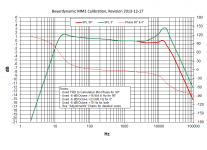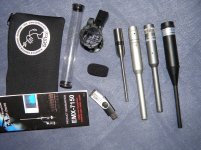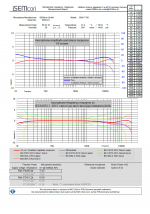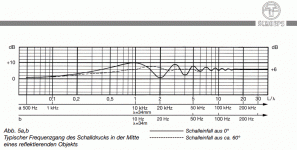dont know.... BUT, many microphones have response at low end into single digit freq. Might be good phase response for speaker
-RNM
-RNM
A 1/4" microphone capsule will pretty much have a minimum-phase response in the whole frequency range of interest, so you can actually get it from the magnitude response alone.
This is not easy to do down low using automated methods, as you would need a magnitude response that goes much lower than 10Hz to actually be able to calculate phase response down to that frequency.
That is why iSEMcon do not use calculation for the lower range and rely on actual comparison instead. It is still minimum-phase though, and even if information is missing to accurately calculate it, you can still manually predict it by interpolating the behavior of the mic down low.
There was a functionality introduced in rephase 1.1.0 that will let you do that:
It was rename to "inverse" in later versions.
I used it to retrieve phase information on my cross-spectrum (Herb) calibrated Dayton mic which was missing phase information.
You simply load the magnitude correction file, hide phase info (if any), inverse it, and then work your way through (minimum-phase) EQs to get it flat, as well as (minimum-phase) filters to model the high pass behavior (which is the critical part).
jmbee also did it and published a detailed description of the process (cannot find the link at the moment, not sure it was on this forum).
It work, and it also let you "rub out" some strange deviations in the correction response that look more like measurement/calibration process artifacts that real capsule behavior.
This is similar to the method I used. Just one additional point:
The SPL response is different for different mic orientations. The phase response is the same no matter the mic orientation. I believe I read in an old B&K mic information document that the mic phase is the minimum phase of the mic's pressure response. The mic pressure response is typically close to the mic 90° SPL response rather than the 0° response.
Assuming I remember this correctly, it is best to use the 90° SPL response for the phase calculation.
While I personally use the mic phase response in my setup, I do agree that using it has a minor impact at the extremes and is very probably of no practical importance.

Pano, can you move my original post from this thread to #1, for clarity?
Also, delete this thread when you are done?
Thank you.
Also, delete this thread when you are done?
Thank you.
In case it wasn't mentioned, or I overlooked it, ISECmon does offer a measurement mic that specifies its phase response and distortion limit: http://www.isemcon.com/datasheets/EMX7150-US-r04.pdf
Thanks had one of those about a year ago because verse USB types wanted the better timing reference possibilityes but it hasn't any build in phase response settings into correction file, thereby wonder if phase is into wesayso's ECM8000 correction file from same company.
That said its nice product and useful accessories as seen to the left in picture below and also raw response is better than UMM-6 and UMIK-1.
Attachments
Yes, mine is a calibrated ECM8000 from iSEMcon with phase correction table included.
At that time I got a CD, not a fancy USB stick like yours 🙂.
Got it somewhere in 2013 when I was still building my speakers, I also have a ECM8000
mic without calibration, never used which I bought in 2011. I wanted something I could
trust and looked into my options (and wallet). This one fit the bill.
At that time I got a CD, not a fancy USB stick like yours 🙂.
Got it somewhere in 2013 when I was still building my speakers, I also have a ECM8000
mic without calibration, never used which I bought in 2011. I wanted something I could
trust and looked into my options (and wallet). This one fit the bill.
Last edited:
AudioVero offers the same microphone calibrated for their software.
I wonder what process they use to calculate the phase response.
Maybe they came up with something more advanced?
It is also quite cheaper.
I wonder what process they use to calculate the phase response.
Maybe they came up with something more advanced?
It is also quite cheaper.
Thanks feedback wesayso think i drop them a message into subject, and yes they had different kits and to have the shockmount adapter included CD was exchanged with that fancy USB stick. There is note included for calibration process verse the B&K 4133 reference and that note have phase curve plotted but the freefield and diffuse calibration files have none phase data included.
Attachments
I asked Wolfgang for the diffuse field data for a calibrated mic I bought from him several years ago, as it did not come with that data at time of purchase. He was very helpful in getting it to me. Maybe you could ask for the phase data for your mic...
I was thinking of taking some speaker distortion measurements and the EMX7150 was the only mic I could find that has a distortion spec.
The only other mic I hear about is the Earthworks M series: Measurement Microphones I have asked support for both distortion and phase specs, but no reply yet. Their page on phase: Phase
BRYTT, cool, what mic are you using now? Oher suggestions on low distortion measurement mic with phase response data? sax512, I am also interested in the approach to phase calibration.
I was thinking of taking some speaker distortion measurements and the EMX7150 was the only mic I could find that has a distortion spec.
The only other mic I hear about is the Earthworks M series: Measurement Microphones I have asked support for both distortion and phase specs, but no reply yet. Their page on phase: Phase
BRYTT, cool, what mic are you using now? Oher suggestions on low distortion measurement mic with phase response data? sax512, I am also interested in the approach to phase calibration.
there's really no psychoacoustic reason for worrying about channel matched linear phase/group delay above ~4kHz
we do have some "time domain" resolution below that but the nerves simply don't fire fast enough to encode phase in upper audio frequencies
people misconstrue intra-aural group delay resolution - which may be better than 10 us (only reliably heard with headphones, much poorer resolution with speakers in rooms)
which relies on the neural system performing correlation on the nerve pulse trains from both ears - and is not evidence of "100 kHz hearing"
small diaphragm condenser mics with flattish frequency response will be more than smooth enough in phase response for anything justified by human hearing limits
you may want known, extended response for diagnosing physical acoustic problems in transducer design but for loudspeaker EQ for listening I don't think the expense of Earthworks, Aco Pacific, or B&K 50 kHz calibrated mics is justified
we do have some "time domain" resolution below that but the nerves simply don't fire fast enough to encode phase in upper audio frequencies
people misconstrue intra-aural group delay resolution - which may be better than 10 us (only reliably heard with headphones, much poorer resolution with speakers in rooms)
which relies on the neural system performing correlation on the nerve pulse trains from both ears - and is not evidence of "100 kHz hearing"
small diaphragm condenser mics with flattish frequency response will be more than smooth enough in phase response for anything justified by human hearing limits
you may want known, extended response for diagnosing physical acoustic problems in transducer design but for loudspeaker EQ for listening I don't think the expense of Earthworks, Aco Pacific, or B&K 50 kHz calibrated mics is justified
Last edited:
I am more concerned with phase accuracy in the lower frequencies, in fact.
I agree with you on the upper frequency limit of human hearing, incidentally, but let's not turn this thread into yet another digital vs analog audio one, for the love of God 🙂
I agree with you on the upper frequency limit of human hearing, incidentally, but let's not turn this thread into yet another digital vs analog audio one, for the love of God 🙂
Hello all,
Which microphones do you guys use for your speaker's measurements and how can you be sure it is phase linear?
This (ECM8000: phase response? - Home Theater Forum and Systems - HomeTheaterShack.com) is an old thread but it looks like there really is no way to measure a microphone's phase response, at least up until a few years ago.
Any thoughts?
If the microphone follows the "minimum phase" behaviour, it's phase response can be directly determined from the magnitude response. When I implemented the microphone compensation in MATAA, I simply assumed minimum phase, as I see no reason to believe that (good) measurement microphones are not minimum phase. However, I have to admit that I have not seen any convincing arguments that actually support this assumption.
To directly measure the full transfer function of a microphone (magnitude and phase), a sound source with a known Fourier spectrum is required (magnitude and phase). The attached document describes how Earthworks do this.
Attachments
at high audio frequency wave lengths become similar order as mic diameter - so a zoo of nearfield, k number, orientation effects modify the response, most of which effects are nonminum phase as far as I know
SPL means 'sound pressure level' which IS pressure response, no difference. And it varies with incident angle.The SPL response is different for different mic orientations. The phase response is the same no matter the mic orientation. I believe I read in an old B&K mic information document that the mic phase is the minimum phase of the mic's pressure response. The mic pressure response is typically close to the mic 90° SPL response rather than the 0° response.
The phase thing is interresting though, do you have a reference for that?
I've learned that mics are min-phase and the rising and ripply response at HF is the exact same phenomenon than a speaker's baffle step, which is minimum phase.
How could the *same* pressure response pattern at the same time be non-minimum phase for a microphone and minphase for a speaker? EDIT: I see jcx asking the same question....
See attached plot from a Schoeps document, Joerg Wuttke's "Microphone Essays" (the most reputable source you might find on microphones), showing reponse rise of a point receicer at the center of a disc, exactly how typical electret capsule construction look like. EDIT: it's not a disc, it's a square, but response pattern aren't too different.
Attachments
Last edited:
There still is a problem here. If one cannot reliably measure about a half decade beyond the required frequency limits the reconstructed phase information might be too noisy and unreliable because one can't apply proper smoothing to the raw mag data near the freq limits.If the microphone follows the "minimum phase" behaviour, it's phase response can be directly determined from the magnitude response.
There still is a problem here. If one cannot reliably measure about a half decade beyond the required frequency limits the reconstructed phase information might be too noisy and unreliable because one can't apply proper smoothing to the raw mag data near the freq limits.
Why do you need smoothing to calculate minimum phase (Hilbert transform)?
I believe I read in an old B&K mic information document that the mic phase is the minimum phase of the mic's pressure response.
That's interesting (assuming by 'pressure response' you mean magnitude response)!
Can you find that document or a reference to it again?
If the microphone follows the "minimum phase" behaviour, it's phase response can be directly determined from the magnitude response. When I implemented the microphone compensation in MATAA, I simply assumed minimum phase, as I see no reason to believe that (good) measurement microphones are not minimum phase. However, I have to admit that I have not seen any convincing arguments that actually support this assumption.
To directly measure the full transfer function of a microphone (magnitude and phase), a sound source with a known Fourier spectrum is required (magnitude and phase). The attached document describes how Earthworks do this.
Thank you, mbrennwa.
I too was thinking that the knowledge of the Fourier transform of a signal could be used, like log sine sweep. But this brings up the problem of how to translate that electrical signal into an equivalent pressure wave. That would require a perfect speaker.
It seems like this is a catch 22 situation.
I would have assumed one can more easily rely on the microphone response to measure the speaker than the other way around, but reading the article it looks like it is not to be so expected.
Unfortunately the article doesn't really offer much info, or should I say hope, about time measurement (phase), but hopefully technology advanced some more since it was written.
Because it is so sensitive to noise. A completely invisible 0.1dB noise-induced wiggle in the mag response can easily result in a 10° phase error, depending on the rate of change of the slopes of the wiggle. I've always found that one needs very robust measurements to get reliable/repeatable phase data from Hilbert Transforms.Why do you need smoothing to calculate minimum phase (Hilbert transform)?
Smoothing is a way to reduce noise with a given already measured IR (assumed we are still in the flat passband -- otherwise smoothing itself alters mag response too much). Of course it is even better to reduce noise in the IR measurement by using long sweeps, high levels and time domain averaging etc, so that less smoothing, if any, is needed.
I too was thinking that the knowledge of the Fourier transform of a signal could be used, like log sine sweep.
Aehm, just to avoid confusion, a Fourier transform is not the same thing as a log sine sweep. The sweep is often used as a test signal. The Fourier transform is a mathematical method to transform the test signal data from the time domain to the frequency domain.
But this brings up the problem of how to translate that electrical signal into an equivalent pressure wave. That would require a perfect speaker. It seems like this is a catch 22 situation.
You don't need a perfect speaker. All you need is a sound source with a known frequency response (magnitude and phase), or known impulse response (which is essentially the same information, see Fourier transform above). You could then disentangle the speaker response and the microphone response from the measured response to obtain the microphone response (magnitude and phase). However, it's still a chicken-and-egg problem, because you need a microphone with a fully known response function to determine the speaker transfer function first. Oh, an anechoic room would also be helpful for this, because room reflections will otherwise be important in the measured response(s), and they will be different if everytime you swap the microphone (except if you can manage to reposition the mics to the very same position within 1mm or better).
Or you could just forget about the speaker idea an do what Earthworks does (as described in the article). They use a "perfect" acoustic Dirac impulse. This has a very well known Fourier spectrum (constant magnitude and no phase change throughout the entire spectrum). But it's not easy to produce a sufficiently "perfect" impulse.
I would have assumed one can more easily rely on the microphone response to measure the speaker than the other way around, but reading the article it looks like it is not to be so expected.
People usually buy a microphone and rely on the calibration data that comes with it (sometimes a bad idea). Or they send their microphones to a lab that determines the calibration data for them (often much better). This is almost always done by comparison to another microphone, with a (hopefully) well known response (yes, we're back to chicken and eggs).
Unfortunately the article doesn't really offer much info, or should I say hope, about time measurement (phase), but hopefully technology advanced some more since it was written.
They recently discovered a possibly inhabitable planet a few light years away from us. Not much has changed with respect to the physics of microphone calibration, though. But I believe the article has more than you realised; it explains how they solve the chicken-and-egg problem in the calibration of their microphones by using an acoustic Dirac impulse produced by that spark thingy. This yields both magnitude and phase response.
- Status
- Not open for further replies.
- Home
- Design & Build
- Equipment & Tools
- State of the art of measurement microphones phase response calibration
 Thread combined with posts moved from rePhase thread
Thread combined with posts moved from rePhase thread


